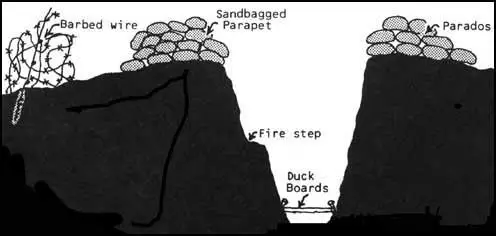Sandbags
The top two or three feet of the parapet and the parados (the rear side of the trench) would consist of a thick line of sandbags to absorb any bullets or shell fragments. Sandbags were filled with earth. A filling party usually consisted of one soldier shovelling the earth and two holding and tying the bags. The men stacking the filled bags worked in pairs and were expected to move sixty bags an hour. Research by the British Army suggested that a typical bullet used in the First World War would only penetrate fifteen inches into a sandbag.

Primary Sources
(1) Guy Chapman, A Passionate Prodigality: Fragments of Autobiography (1933)
The trench was not a trench at all. The bottom may have been two feet below ground level. An enormous breastwork rose in the darkness some ten or more feet high. All about us there was an air of bustle. Men were lifting filled sandbags on to the parapet and beating them into the wall with shovels. Bullets cracked in the darkness. Every now and then a figure would appear on the skyline and drop skillfully on the firestep.
"Care to see the wire?" said my guide. I followed him gingerly over the edge of the wall, and slid clumsily down a ramp of greasy sandbags. A small party was working swiftly over a tangle of some dark stuff. Two of my own soldiers were being inducted into the ceremony of wiring. "Hold it tight, chum," growled one figure. He proceeded to smite a heavy bulk of timber with a gigantic maul, the head of which had been cunningly muffled in sandbags.
(2) John Raws, letter to his mother (9th July 1916)
The fortification consists of breastworks, built up high to the front, with just a little shallow trench dug behind. The reason is that drainage is so difficult. These breastworks are made of millions of tightly-made sandbags laid one upon the other, packed well together. Every eight yards there is an island traverse, a great mound of earth and sandbags strengthened by rivetting, round which the trench winds. This is to localise the explosion of shells or prevent an enemy who might reach the flank being able to pour fire right down the length of a trench. There are communication trenches back every few yards and innumerable succeeding lines for the main army. The whole network extends in most places for three or four miles. The dug-outs are all in lines, but mostly along the communication trenches.
When there is no excitement there are about two sentries to every sector of say 9 yards on watch, and one officer for the company. The rest are in the dugouts. When a bombardment comes or there is a gas alarm, everyone rushes out and takes what cover one can in the front trench, awaiting developments. Against the front breastwork we have a step, about two feet high, upon which men stand to shoot. When there is a bombardment nearly everyone gets under this step, close in against the side.
